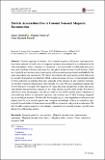Files in this item
Particle acceleration due to coronal non-null magnetic reconnection
Item metadata
| dc.contributor.author | Threlfall, James William | |
| dc.contributor.author | Neukirch, Thomas | |
| dc.contributor.author | Parnell, Clare Elizabeth | |
| dc.date.accessioned | 2017-03-30T15:30:13Z | |
| dc.date.available | 2017-03-30T15:30:13Z | |
| dc.date.issued | 2017-03 | |
| dc.identifier | 249094416 | |
| dc.identifier | 6f32fc2d-b5e3-454a-a3d1-a60ff705d6f8 | |
| dc.identifier | 85015888303 | |
| dc.identifier | 000398052300006 | |
| dc.identifier.citation | Threlfall , J W , Neukirch , T & Parnell , C E 2017 , ' Particle acceleration due to coronal non-null magnetic reconnection ' , Solar Physics , vol. 292 , 45 . https://doi.org/10.1007/s11207-017-1060-0 | en |
| dc.identifier.issn | 0038-0938 | |
| dc.identifier.other | ORCID: /0000-0002-7597-4980/work/34032271 | |
| dc.identifier.other | ORCID: /0000-0002-5694-9069/work/73700731 | |
| dc.identifier.uri | https://hdl.handle.net/10023/10551 | |
| dc.description.abstract | Various topological features, for example magnetic null-points and separators, have been inferred as likely sites of magnetic reconnection and particle acceleration in the solar atmosphere. In fact, magnetic reconnection is not constrained to solely take place at or near such topological features and may also take place in the absence of such features. Studies of particle acceleration using non-topological reconnection experiments embedded in the solar atmosphere are uncommon. We aim to investigate and characterise particle behaviour in a model of magnetic reconnection which causes an arcade of solar coronal magnetic field to twist and form an erupting flux rope, crucially in the absence of any common topological features where reconnection is often thought to occur. We use a numerical scheme which evolves the gyro-averaged orbit equations of single electrons and protons in time and space, and simulate the gyromotion of particles in a fully analytical global field model. We observe and discuss how the magnetic and electric fields of the model and the initial conditions of each orbit may lead to acceleration of protons and electrons up to 2 MeV in energy (depending on model parameters). We describe the morphology of time-dependent acceleration and impact sites for each particle species and compare our findings to those recovered by topologically based studies of three-dimensional (3D) reconnection and particle acceleration. We also broadly compare aspects of our findings to general observational features typically seen during two-ribbon flare events. | |
| dc.format.extent | 19 | |
| dc.format.extent | 4644006 | |
| dc.language.iso | eng | |
| dc.relation.ispartof | Solar Physics | en |
| dc.rights | © The Author(s) 2017. This article is distributed under the terms of the Creative Commons Attribution 4.0 International License (http://creativecommons.org/licenses/by/4.0/), which permits unrestricted use, distribution, and reproduction in any medium, provided you give appropriate credit to the original author(s) and the source, provide a link to the Creative Commons license, and indicate if changes were made. | en |
| dc.subject | Energetic particles, acceleration | en |
| dc.subject | Magnetic reconnection, observational signatures | en |
| dc.subject | Magnetic reconnection, theory | en |
| dc.subject | Magnetic fields, corona | en |
| dc.subject | Flares, relation to magnetic field | en |
| dc.subject | QB Astronomy | en |
| dc.subject | QC Physics | en |
| dc.subject | NDAS | en |
| dc.subject.lcc | QB | en |
| dc.subject.lcc | QC | en |
| dc.title | Particle acceleration due to coronal non-null magnetic reconnection | en |
| dc.type | Journal article | en |
| dc.contributor.sponsor | Science & Technology Facilities Council | en |
| dc.contributor.sponsor | Science & Technology Facilities Council | en |
| dc.contributor.institution | University of St Andrews.Applied Mathematics | en |
| dc.contributor.institution | University of St Andrews.School of Mathematics and Statistics | en |
| dc.identifier.doi | 10.1007/s11207-017-1060-0 | |
| dc.description.status | Peer reviewed | en |
| dc.identifier.grantnumber | ST/N000609/1 | en |
| dc.identifier.grantnumber | ST/K000950/1 | en |
This item appears in the following Collection(s)
Items in the St Andrews Research Repository are protected by copyright, with all rights reserved, unless otherwise indicated.

